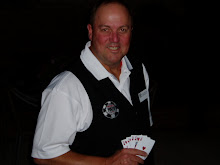Just a few work days left to clean up the Main Event. Probably some highlights to come, but here are some of the highlights of my WSOP experience so far:
Dealt H.O.R.S.E. Final Table in the Arena "Thunderdome" where there was prize pool over a million dollars, won by Tommy Hang.
Dealt $1500 Draw Lowball Final Table won by Steve Wolansky.
Dealt $10k Draw Lowball Final Table where Paul Volpe defeated a table of pros including Jason Mercier and Daniel Negreanu to put a cool quarter million dollars in his pocket. During play, when I dealt Daniel a winner, his rooting section starting cheering, "Go Buz! Go Buz!" Daniel remarked, "Wow! Dealer fans. Cool!"
I also dealt the Final Table of the $10k 7-Card Stud World Championship where I dealt the back to back hands that eliminated Phil Hellmuth in sixth place after starting the Final Table third in chips. Matt Grapenthien won it by overcoming Todd Brunson's huge initial chip lead in a marathon heads up battle that lasted long after the evening shift took over.
I know I represent all 1100 WSOP dealers when I do a final table, especially when it's being broadcast. I try to be smooth, precise and professional, and not look too nervous in front of the cameras. I hope I represented you well.
I want to thank the folks like Robbie and Bos who over the years have made suggestions to me on how to be a better, more professional dealer and also my friends, who among them are some of the best Poker dealers in the entire world. — feeling blessed.
Dealt H.O.R.S.E. Final Table in the Arena "Thunderdome" where there was prize pool over a million dollars, won by Tommy Hang.
Dealt $1500 Draw Lowball Final Table won by Steve Wolansky.
Dealt $10k Draw Lowball Final Table where Paul Volpe defeated a table of pros including Jason Mercier and Daniel Negreanu to put a cool quarter million dollars in his pocket. During play, when I dealt Daniel a winner, his rooting section starting cheering, "Go Buz! Go Buz!" Daniel remarked, "Wow! Dealer fans. Cool!"
I also dealt the Final Table of the $10k 7-Card Stud World Championship where I dealt the back to back hands that eliminated Phil Hellmuth in sixth place after starting the Final Table third in chips. Matt Grapenthien won it by overcoming Todd Brunson's huge initial chip lead in a marathon heads up battle that lasted long after the evening shift took over.
I know I represent all 1100 WSOP dealers when I do a final table, especially when it's being broadcast. I try to be smooth, precise and professional, and not look too nervous in front of the cameras. I hope I represented you well.
I want to thank the folks like Robbie and Bos who over the years have made suggestions to me on how to be a better, more professional dealer and also my friends, who among them are some of the best Poker dealers in the entire world. — feeling blessed.

